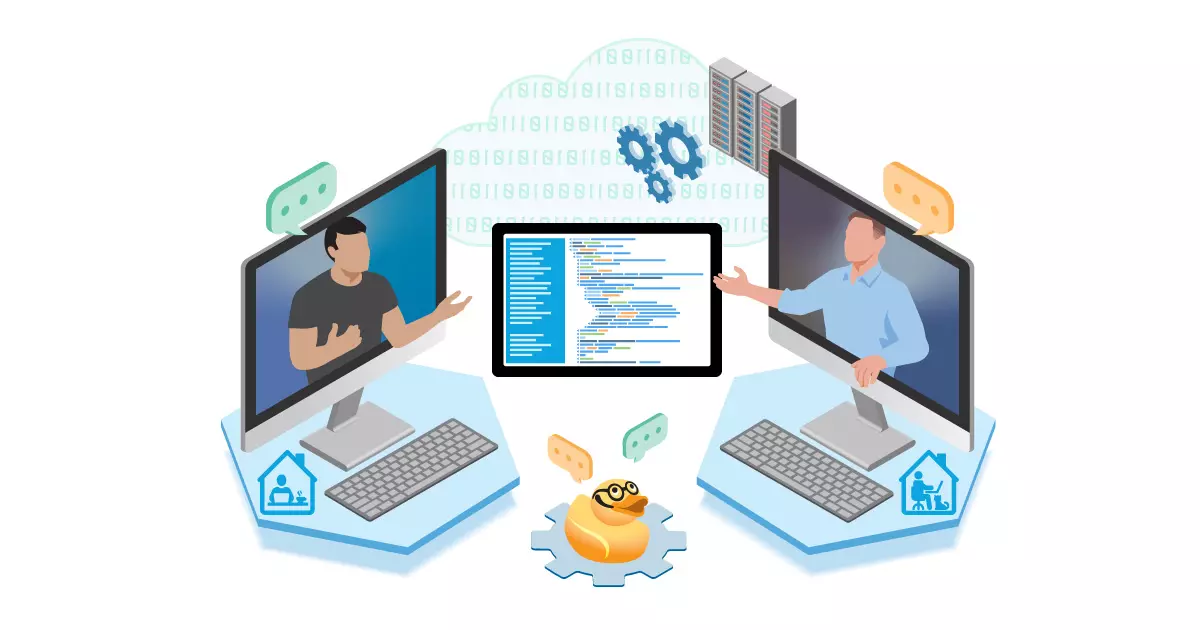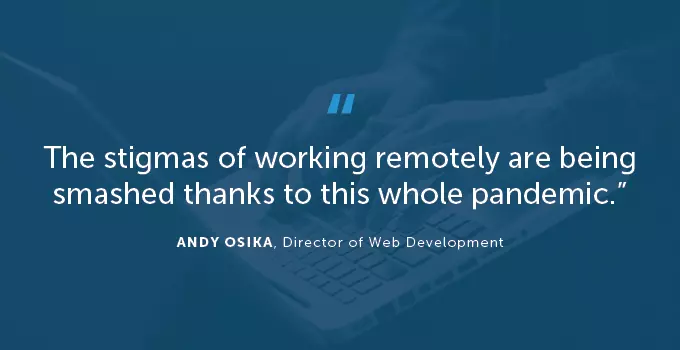Managing a Tech Department During a Pandemic

Join us for an insider’s look at how our agency tech department navigated the pandemic and get tips on setting up your tech team for work-from-home success.
Ever since this pandemic began in March, Godfrey employees have been working from home. And while the agency already had a strong foundation in place to support a pretty seamless transition to this unexpected shift, there are some challenges that can creep up along the way.
We decided to check in with Andy Osika, our director of web development, to see how his department of software developers are managing. It was an all-around enlightening conversation that prompted some helpful tips from Andy on how other companies can make the most out of this situation.
Godfrey: Thanks for taking some time to chat. Let’s start by asking how you and your team have been managing.
Andy: From a move to remote perspective, it’s been almost seamless. My team already had access to the network to work from home long before the pandemic. Even though we all sat in small individual workspaces in our area of the building, we still used Microsoft Teams to pass coding tips or share snippets with each other. You could say we were least affected in those two areas. The bigger area was the communication vacuum that happened due to the pandemic. As I alluded to earlier about our work area, there was constant chatter over the walls about the ups (woohoos when you figure something out) and downs (the occasional expletive when stumped) throughout the course of the day. When someone needed help, we simply popped over to the person’s desk and worked through the problem. Being fully remote has definitely sapped that communication as that’s one of the things we all enjoyed about being together. Speaking of communication, I’m encouraging everyone to overshare at this point. It’s easier to dial things back than to be missing out on things due to lack of communication.
Godfrey: And you’ve recently hired a new employee. How has the onboarding been going? Are you doing a mix of in-person and remote?
Andy: This has been interesting in that it ended up being a different outcome than what I initially expected. We started off two days a week in office, expecting being in person would be beneficial for onboarding, pair programming, etc. After two weeks, we abandoned this approach because when we were “together,” we still had to be six feet apart, which makes pair programming a little difficult. Enter the all-day Zoom session. I literally shared my screen all day, and we worked together to complete tasks. He had the benefit of seeing my screen close up, had quick and easy access to a browser to review concepts more in depth, and I could grant control for him to take over. It ended up being much more effective for our line of work than what I originally anticipated.
Godfrey: Have you gained any efficiencies working remotely?
Andy: The lack of commute has been beneficial. Also, having a proper setup is key to being productive. Fortunately, my home office is set up to allow for that. I’ve got two large monitors, my tools open and am able to quickly switch between them. Another added benefit is that we don’t have to rely on a server — our cloud-based services allow us to do things more quickly. I’ve also noticed there are less interruptions.
Godfrey: What are some drawbacks to working remotely?
Andy: There’s definitely a grey line of maintaining a work-life balance — you have to be super mindful of shutting off outside working hours.
Godfrey: How has collaboration with your team been?
Andy: Luckily, we’ve got a solid foundation to work from — lots of cloud-based tools that allow for effective collaboration. Overall, we’re pretty siloed so we use screen shares to walk people through what’s going on or walk end users through things — that replaces walking into someone’s office to see how they’re doing something.
Godfrey: What kind of feedback have you gotten from your employees about working remotely?
Andy: Overall, it’s been positive. The biggest challenge is having young kids and managing work with kids being home. I understand what it means to have kids running around when you’re working, but overall, I think people enjoy the fact they have flexibility to work from home. Software development, pre-COVID, we’ve been able to offset hours to do what we need to do because that’s the nature of our work. We were set up for success because that’s how we worked already. We didn’t need a lot of help to work remotely because we already did it.
Godfrey: Have there been any surprises?
Andy: I think the biggest thing people miss is the chatter, human-to-human connection, that you just don’t get working from home. A video call isn’t the same as being together. You don’t get the same vibe when you’re interacting with people in person. Conversation happens organically when we’re together because we’re in the same workspace. You’ll hear an “ooh” or a grunt, and it’s those cues you pick up on and just ask about it and that fosters conversation naturally. Whereas if someone is frustrated and home, they’d have to proactively reach out. We call it a rubber ducky — talk out loud about what you’re trying to fix and, 95% of the time, as you talk through the problem, the answer comes to you. And that’s the whole rubber ducky solution. Those things are missed when you’re not together.
Godfrey: Did it uncover any gaps or things you wish you had?
Andy: Some things we’ve talked about are to replicate the in-office experience — have a meeting room open all day where everyone is signed in so people can go in and chatter, but that hasn’t really taken off. So, we’re still trying to find alternative solutions to simulate a more human-to-human experience.

Godfrey: How do you see the future of working remotely for your department?
Andy: If this pandemic has proven anything, it’s that Godfrey is well-equipped to work from home. It’s also attractive to prospective employees to have that flexibility. The stigmas of working remotely are being smashed thanks to this whole pandemic. The flip side, from a manager’s perspective, that requires trusting your employees. Keeping lines of communication open. I have trust in my employees that they’re doing their work and getting it done. I’m able to leverage the tools we have in place to be able to help manage tasks and projects more easily than we have in the past.
Set Your Team Up for Remote Success
While working from home has become the norm, companies are still finding they need to be flexible and adjust as they go. Especially if there are new hires. Andy offers some tips to make internal teams feel supported and productive.
- Utilize real-time collaboration tools like Zoom, Microsoft Teams or Skype. And don’t be shy — use the camera feature! Seeing someone’s face goes a long way in a meeting.
- Have the appropriate project management software to manage tasks effectively and efficiently, whether that’s tools like Workfront or Jira.
- Piggybacking off the right tools, explore various cloud-based services as an alternative to on-premise servers. Examples like Azure or Amazon Web Services allow organizations and their employees more flexibility and greater functionality.
- Have a proper workspace at home that simulates your in-office setup. For example, 2-3 large monitors.
- Hold weekly department meetings and one-on-one meetings. You have to be proactive with communication. Sometimes it feels like overcommunicating expectations and requests. When working remotely, it can be easy to go dark. So, you really can’t communicate enough.
- Working from home during this pandemic has brought work and home life closer together. Being flexible is key so employees can deal with both work and home situations.
- Onboarding can be done successfully, but the effort must be made. No new employee wants to be sitting around twiddling their thumbs. Try to keep them tasked and engaged as much as possible, ideally not just working by themselves.
- Experiment with longer Zoom sessions where people can hop in and out. That can help replace the “in-office” feeling.
Sign Up for our Newsletter - Get agency updates, industry trends and valuable resources delivered directly to you.
Andy Osika - Director of Web Development




